How a US fintech app achieved top rankings in the UK within 21 days? A strategic approach through successful keyword installs campaigns.
- Overview:
- Understanding UK Fintech App Competition
- Our Keyword Strategy for Market Entry
- The 21-Day Campaign Execution
- Results and Key Learnings
- Best Practices for Market Expansion Through Keyword Promotion
- Conclusion
Expanding a successful app into new geographical markets presents unique challenges that go far beyond simple translation. Cultural nuances, local competition, and regional search behavior can make or break an international launch, regardless of how well your app performed in its home market. This case study reveals how strategic keyword positioning and localized keyword installs campaigns enabled a US fintech app to establish dominance in the competitive UK market in just three weeks.
With over ten years of experience in keyword promotion across diverse markets, Keyapp has developed proven strategies for international app expansion. This real-world example demonstrates how understanding local user behavior and implementing data-driven decisions can overcome the obstacles of entering established markets with strong competitors.
Understanding UK Fintech App Competition
The UK fintech and personal finance app market has experienced remarkable growth, driven by several converging factors that make it both attractive and intensely competitive. British consumers have embraced digital banking and financial management tools at higher rates than many other markets, creating substantial opportunities for well-positioned apps. However, this same enthusiasm has attracted numerous competitors, both domestic and international.
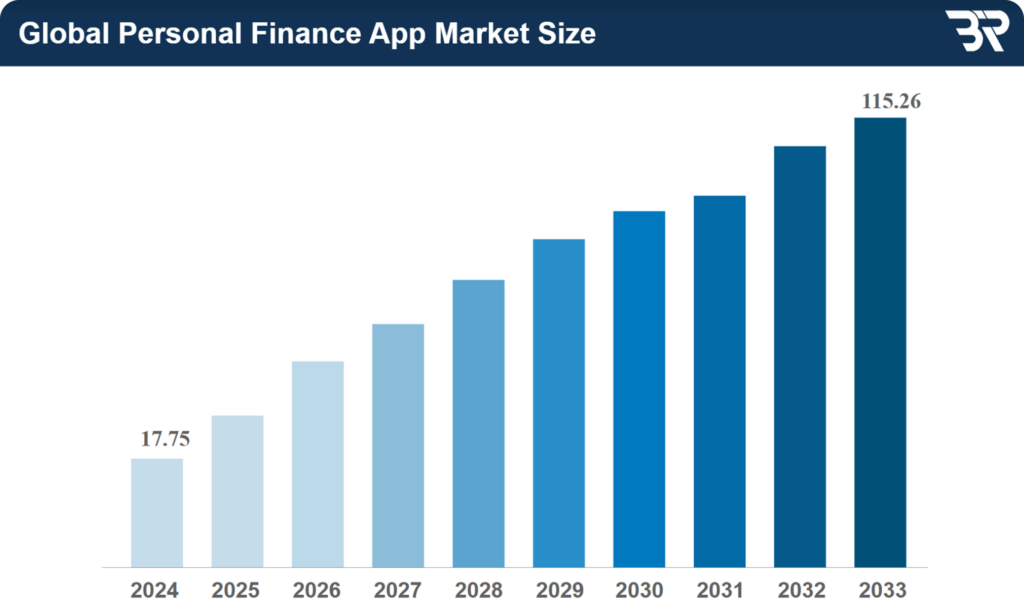
Source
The search behavior patterns we observed in the UK market revealed interesting differences from US users. British consumers tend to use more specific, longer search queries when looking for financial apps, suggesting they conduct more thorough research before downloading. They also show stronger preferences for certain terminology over others. Our analysis revealed that “planner” significantly outperformed “tracker” in search volume and conversion rates, a distinction that many US-focused developers might overlook. Understanding these nuanced preferences became central to our keyword selection strategy.
Our Keyword Strategy for Market Entry
Traditional ASO tools can generate extensive keyword lists based on search volume and competition metrics, but successful market entry requires deeper analysis of actual user behavior and intent. Our approach combined quantitative data with qualitative insights about UK financial app users to identify keywords that would deliver both rankings and meaningful conversions.
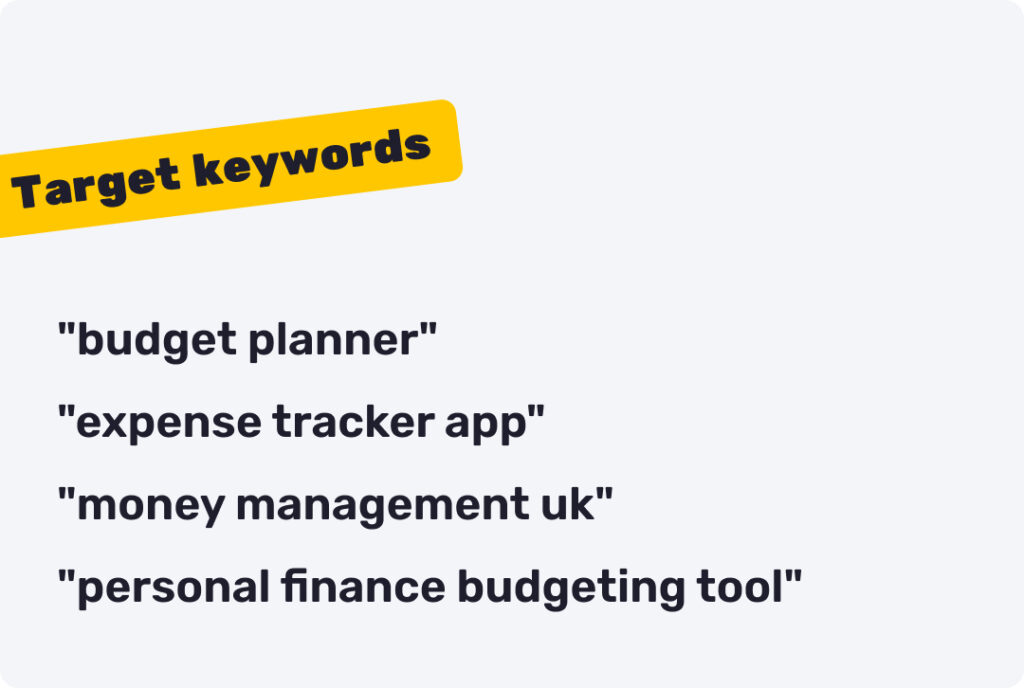
We structured our keyword selection across three tiers, each serving a specific strategic purpose. For our high-frequency anchor, we selected “budget planner” rather than “budget app” or “expense tracker.” Analysis showed that UK users searching for “budget planner” demonstrated higher intent and engagement rates, despite conventional wisdom suggesting that “app” as a modifier would perform better. This keyword would serve as our primary visibility driver, though we knew it would require the most sustained promotional effort to achieve top rankings.
Our mid-frequency selections focused on keywords that combined reasonable search volume with clearer user intent. “Expense tracker app” provided direct functional description and “money management uk” represented a strategic localization choice, incorporating the country identifier to target users specifically looking for UK-relevant financial tools.
For our long-tail strategy, we chose “personal finance budgeting tool” despite its lower search volume. This keyword indicated users with very specific needs who were further along in their research process. These users typically converted at higher rates and showed better retention, making them valuable even in smaller numbers. Additionally, long-tail keywords often require less aggressive promotional campaigns to achieve top rankings, allowing us to demonstrate quick wins early in the campaign.
The 21-Day Campaign Execution
Let’s examine the detailed results we achieved for our client`s app, a US-based personal budget tracking app expanding into the UK market. The campaign structure followed a carefully orchestrated three-week progression, with each phase building on the previous one’s achievements. This 21-day campaign demonstrates how strategic keyword promotion can establish market presence even against entrenched local competitors.
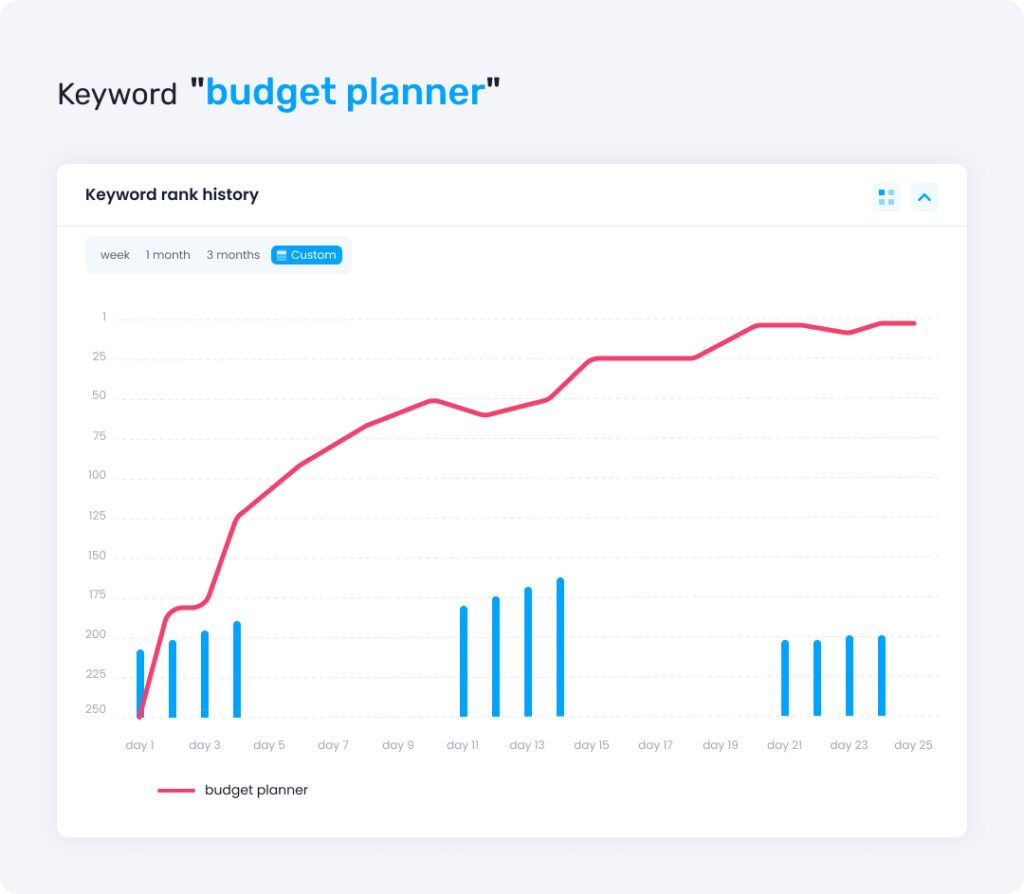
Week One: Foundation and Market Entry
The first week focused on establishing initial rankings and generating algorithmic signals that our client`s app was relevant for our target keywords. We began with conservative daily install volumes that gradually increased as the week progressed. For “budget planner,” we started with 150 installs on day one, then increased to 180, 210, and 240 installs over the subsequent days. This gradual escalation allowed us to test algorithm response.
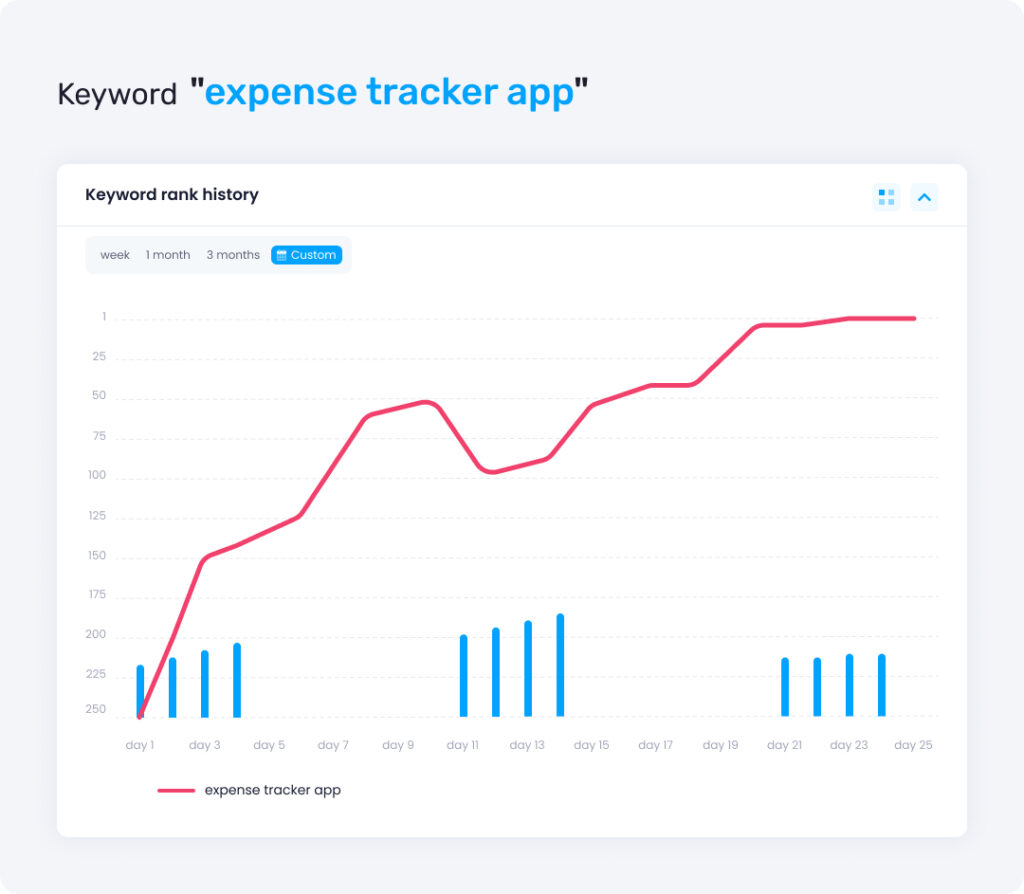
The mid-frequency keywords followed similar progressive patterns but with appropriately scaled volumes. “Expense tracker app” began with 120 installs daily, climbing to 190 by the end of the week. “Money management uk” started at 110 and reached 180. Our long-tail keyword, “personal finance budgeting tool,” required the most modest volumes, starting at just 65 installs and reaching 125 by week’s end.
By the end of week one, we had achieved our initial objective: all four keywords were indexed and ranking within the top 50. This foundation was critical because it established algorithmic recognition of the app’s relevance for these keywords.
Week Two: Acceleration and Position Advancement
With foundation established, week two focused on pushing toward top-five positions across all keywords. We substantially increased daily install volumes while maintaining the same progressive pattern within each week. “Budget planner” campaigns delivered 270 installs on day one of week two, escalating to 310, 350, and reaching 390 installs daily by the end of the week.
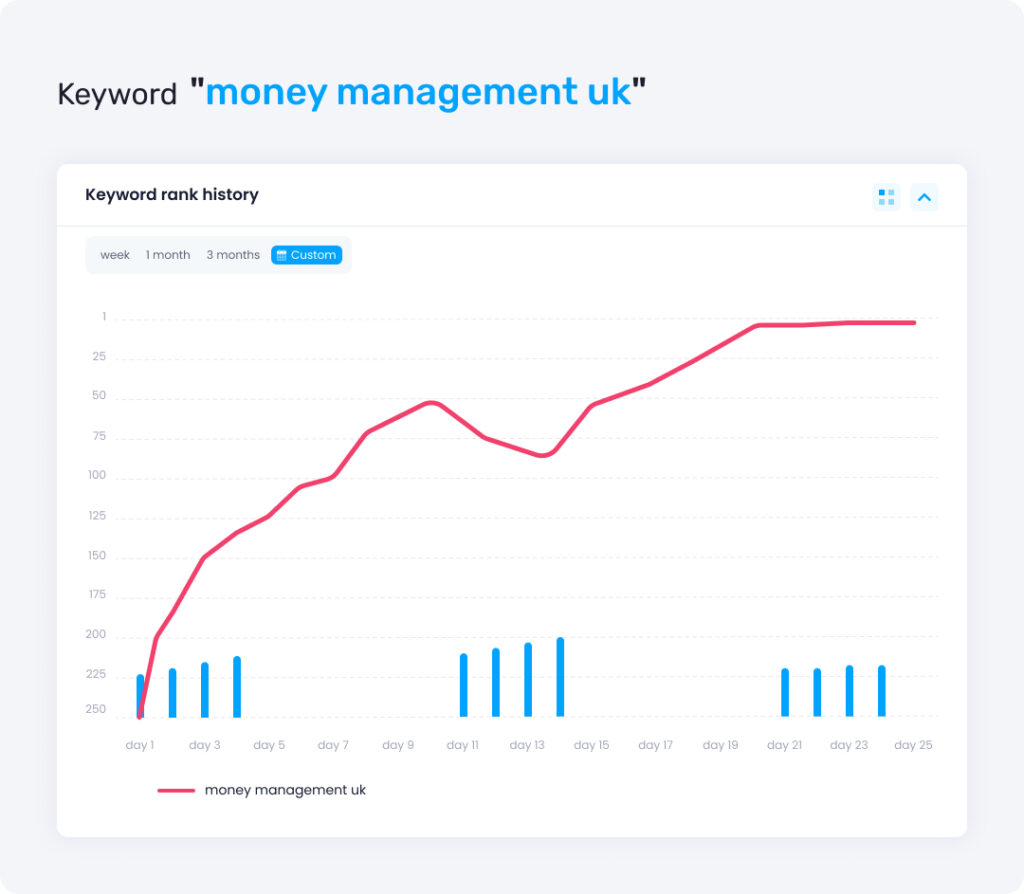
The mid-frequency keywords saw proportional increases, with “expense tracker app” climbing from 210 to 300 daily installs and “money management uk” moving from 200 to 290. Even our long-tail keyword received increased promotion, though at more modest levels, ranging from 145 to 205 installs daily.
This week proved critical as we navigated the challenging transition from mid-pack rankings to top positions. Competition intensifies dramatically in the top ten, as these positions capture the majority of search traffic. We observed typical algorithm fluctuations during this phase, with positions sometimes varying by several ranks during active campaigns before stabilizing. These temporary fluctuations are normal and should not prompt panic or strategy changes. The key is maintaining consistent effort through these oscillations until rankings stabilize at the higher positions.
By the end of week two, we had achieved breakthrough results: all four keywords now ranked within the top five positions, with some already claiming top spots. This achievement in just fourteen days exceeded initial projections and validated the aggressive scaling of our install campaigns.
Week Three: Stabilization and Maintenance
The final week shifted focus to maintaining the achieved positions Rather than continuing aggressive promotion, we reduced daily install volumes to 40-60% of peak levels. This maintenance approach proved sufficient to hold our top-five positions.
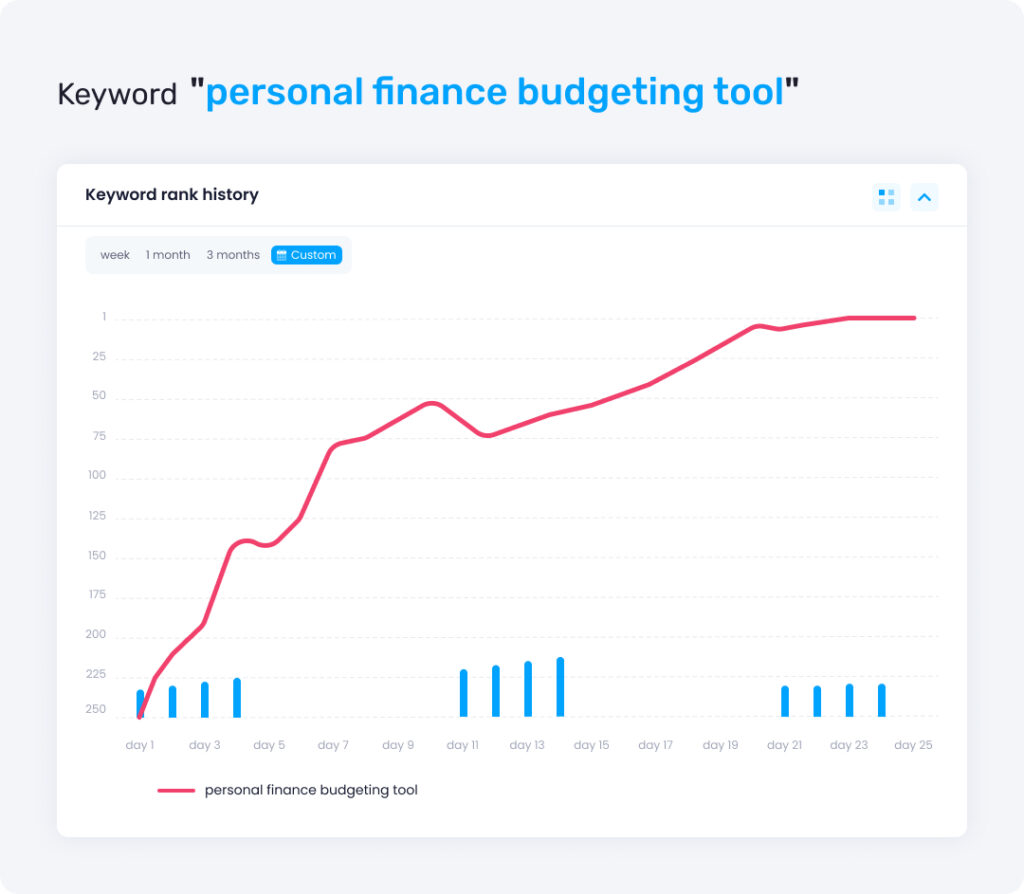
The iOS algorithm’s behavior during this maintenance phase revealed important insights. Rankings that might have seemed precarious actually held steady with much lower ongoing promotion than required to achieve them initially. This phenomenon occurs because the algorithm considers multiple signals beyond just daily installs, including user engagement, retention, and the velocity of these metrics relative to competitors. Once an app demonstrates strong performance in these areas at a given position, maintaining that position requires less ongoing promotional support.
Results and Key Learnings
The campaign delivered exceptional results that exceeded even our optimistic projections. After just 21 days, our client`s app achieved number three ranking for “budget planner,” the highest-volume keyword in our campaign. For “expense tracker app,” we achieved the first position, placing our client`s app ahead of established UK competitors for a highly relevant, high-intent search keyword. “Money management uk” reached second position, and “personal finance budgeting tool” also claimed the top ranking. These rankings translated to significant organic visibility, with the app now appearing in search results for hundreds of related terms beyond our specifically targeted keywords.
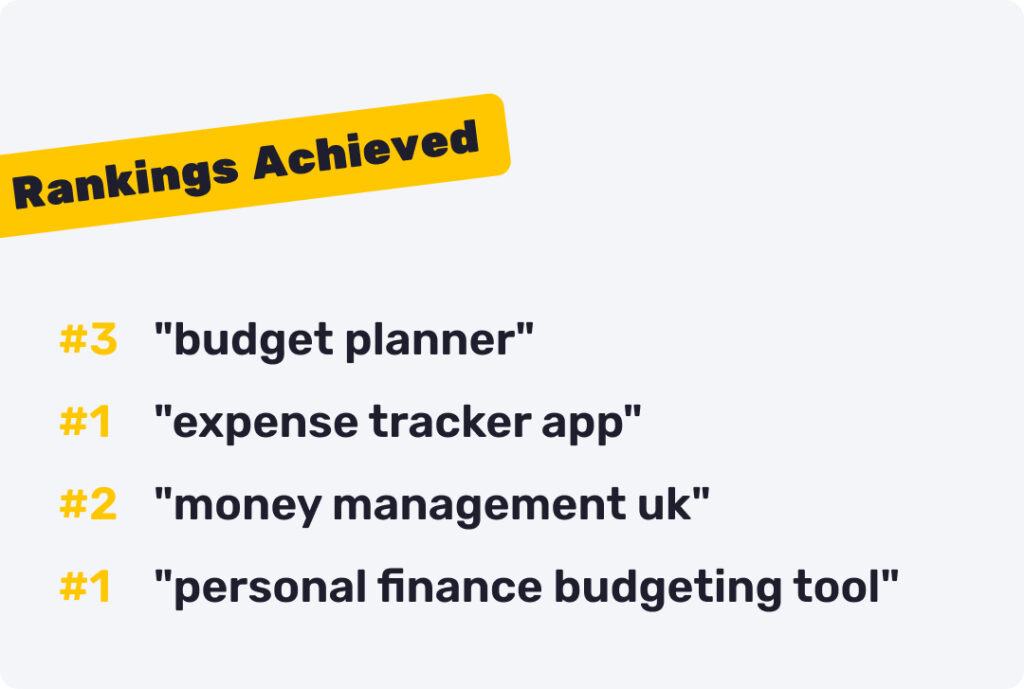
Beyond the ranking numbers themselves, the campaign generated valuable insights about the importance of true localization. Simply translating keywords or content proves insufficient when entering new markets. Understanding local terminology preferences, cultural attitudes toward the app category, and regional competitive dynamics requires dedicated research and often local market expertise.
User preference data confirmed our keyword research findings. UK users demonstrated measurably stronger response to “planner” terminology compared to “tracker,” a distinction that might seem subtle but proved materially important to campaign performance. This underscores the value of deep market research that goes beyond surface-level keyword metrics to understand actual user psychology and search behavior.
Best Practices for Market Expansion Through Keyword Promotion
Successful international expansion requires methodical preparation before launching promotional campaigns. This preparation begins with comprehensive market research that goes well beyond simple keyword metrics. Understanding local competition, user preferences, regulatory considerations, cultural attitudes toward your app category, and regional market dynamics informs every subsequent strategic decision.
App Store Optimization fundamentals must be properly addressed before significant promotional investment. Ensure all metadata is fully localized, not just translated. This means adapting screenshots to reflect local UI preferences and showcasing features that resonate with local users, crafting descriptions that use local terminology and address locally relevant use cases, and incorporating social proof elements that local users find credible. For example, use currency symbols correctly (£ for UK, not $). An app that appears foreign or poorly adapted will struggle to retain users even if promotional campaigns drive initial installs, undermining both immediate conversion rates and long-term algorithmic signals.
Campaign execution should follow a structured progression that aligns with algorithm behavior and budget management principles. Begin with lower-competition keywords to establish initial market presence and generate early algorithmic signals, then progress to more competitive terms as initial success validates your strategy. Monitoring and optimization must extend beyond simple ranking tracking. Watch user engagement metrics including download-to-install conversion rates, day-one and day-seven retention, early user ratings and review sentiment, and session frequency and duration patterns. These metrics indicate whether your keyword targeting is attracting genuinely interested users and whether your app delivers on the expectations your App Store or Google Play presence creates.
Conclusion
This case study demonstrates that strategic market expansion through keyword promotion can achieve remarkable results within compressed timeframes when executed with proper planning, localized insight, and sustained effort. Remember, the fintech app market will only grow more competitive as digital financial services become increasingly central to daily life. Apps that establish strong positions now through strategic keyword promotion and genuine localization will benefit from compounding advantages in visibility, user acquisition cost, and brand recognition.
At Keyapp, we have successfully guided numerous apps through international expansion across diverse categories and markets. Our methodology combines quantitative analysis of keyword metrics and competition with qualitative insights about local user behavior and market dynamics. Whether you are launching in your first international market or expanding to your tenth, understanding local nuances and implementing region-specific strategies dramatically improves success probability.
Ready to expand your app into new markets? Contact Keyapp’s expert team to develop a customized international expansion strategy that delivers sustainable results through localized keyword promotion and deep market understanding.






















